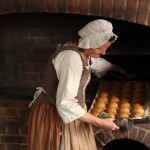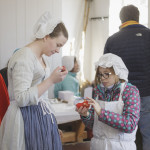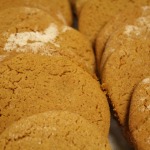
In 1800 an enslaved Virginian named Gabriel Prosser plotted an insurrection in Henrico County near Richmond. His goal reportedly was to kill any white person he came across, sparing only French Huguenots and one named individual. That person was Mary Randolph who, declared Prosser, would cook for him and be his queen.
Why would Prosser single out a white woman of privilege in such a way?
I became interested in Mary’s recipes after making a few as part of my apprenticeship requirements. What stuck out in my mind was how differently she wrote her receipts (the 18th-century term for recipes). They were very straightforward and easy to follow, that is, markedly different from other period recipes, especially the ones from the cookbooks published in Europe. I began to wonder: why did this woman change? Was it her personality or her life circumstances? I knew I needed to learn more.
The Virginia Housewife has been studied and its recipes practiced for almost 200 years. What attracts food historians to continue to practice under Mary’s guidance? After all, looking at other 18th-century cookbooks you would be hard-pressed to find recipes featuring okra, corn meal, or brown flour. The fact that Mary used unusual ingredients has been documented by numerous food historians. The unusual course of her life and loss of economic status has also been studied and analyzed. But what motivated Mary Randolph’s choices of ingredients and recipes, is an area of food history that seems to have been glossed over. It is the reason why one would forego her childhood foods in favor of economical recipes or cheaper ingredients that perplexes this food historian.
Born into one of the leading families of Virginia, Mary Randolph was raised in a world of privilege. “Molly,” as she was known, grew up at Tuckahoe Plantation, the eldest daughter of Thomas Mann and Ann Cary Randolph. The Randolphs were known to hire professional tutors to teach their sons and daughters. Mary would likely have learned reading, writing, arithmetic, and some more advanced subjects. She would also have learned sewing, knitting, and other domestic skills.
Mary married David Meade Randolph in December of 1780. The couple spent the early years of their marriage at Presquile Plantation south of Richmond. David attempted farming and was largely successful as a farmer of his land. However, it proved to be an unhealthy living environment for Mary. The couple would eventually sell the property and move to Richmond.
This marked the high point in the family’s life. David was appointed a U.S. Marshal, and following the construction of their home, Moldavia, the couple began hosting the city’s elite in high style. It was also during this time that Mary’s reputation as a cook began to spread. After her husband David declared bankruptcy in 1807, Mary Randolph opened a boarding house in Richmond.
As historian Cynthia A. Kierner relates, “it was here [that Mary] employed several slaves who had been mortgaged to an unmarried female relation (Mary Stith of Williamsburg) to shield them from David’s creditors. By 1810, the census listed Mary, not David, as the head of a Richmond household that included nine slaves, at a time when the mistress of a typical American boardinghouse had only one or two slaves or servants at her disposal.”
Mary would use her knowledge and training from her childhood to provide a unique business for the Richmond community. She would also use her knowledge of running a plantation to effectively run the new business and ensure its profit. No doubt Mary would work side by side with her enslaved cook, perfecting recipes and dictating how the meal was to be laid out.
Mary’s relationships with her slaves or servants (some may have been free persons of color) likely influenced her use of non-traditional ingredients. What were these relationships like? Did Mary simply come in and dictate the recipe from the cookbook? More likely she worked side-by-side with these women or men, discussing the day’s activities, admiring the produce or the fine weather. Indeed, as this cook can attest, working alongside another cook or two in a kitchen without some laughter and banter creates an awkward environment, and one in which food may not turn out as well as you had planned.
It is clear that African foodways influenced Mary Randolph and her choice of ingredients for The Virginia Housewife. Historian Mary Tolford Wilson called this kind of process “‘peaceful integration’-the adoption of slaves’ food by the slave-owning class.”
To fully comprehend the magnitude of this we must look how traditional African foods can become well established in the American south. Author Anne L. Bower theorized that this may have taken place as a result of keeping slaves alive on the journey across the Atlantic. “Experience taught [slave traders that] although some European foods were acceptable, Africans fared better when fed their customary food.”
By feeding African captives familiar food, survival rates went up, which may have then carried over to the gardens kept by enslaved people. So, returning to the idea of these kitchen conversations, we can imagine Mary and her enslaved members of the household talking about what was growing in the gardens.
Whether for identity purposes, nostalgia, or simply to ensure their survival, the introduction of these African crops began the start of a cross-cultural food exchange. While it is impossible to know what was said in the kitchen with Mary and her slaves this long after her death, there’s evidence that enslaved cooks had a significant influence on how Mary prepared food. And it was a reputation that apparently spread far enough that even Gabriel Prosser expressed a peculiar admiration for her skills.
Interested in trying out a Mary Randolph recipe for yourself? Try this one for chicken pudding!



I’ve actually tried a variation of some of these and they worked perfectly and everything tasted delicious! Excited to try out some different variations! Thanks!
I did not find in the post the date that her cookbook was first published. Some articles I’ve read suggest the book was created because of her reduced circumstances.
Linda, according to Melissa Blank, who wrote the blog, the book was published in 1824, but the recipes she uses are from her life experiences during the late eighteenth century.
A true American story! A combination of cultures, a story of hardship and challenges. This would make a good Masterpiece Theater series.
Fascinating article! Makes me eager to explore further. Thanks!